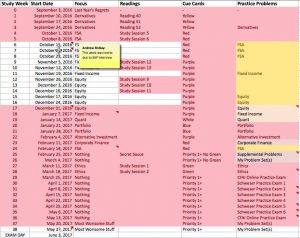Another CFA® Exam is Finished
June 4th, 2017
And after approximately six hours of actual exam test writing, numerous hours of stress, one emergency surgery and having followed a nine month study plan, I fear I may have done better last year. Last year I managed to get Band 10 on the CFA® Level 2 Exam. Self appointed online experts hypothesized my mid-band scores in Financial Report Analysis and Fixed Income were too low, so I dutifully studied those topics and every other topic again. I carefully tracked my performance in practice exams and I did certain sample problems over and over. I still fear it was not enough.
Update: Apparently the final nine months of studying for the Level 2 CFA exam was enough, as I passed. I then persisted another twelve months and passed the CFA Level 3 exam as well. Finally, I wrote out a few more thoughts on what a long, hard, slog, the CFA Program is.
Being a a CFA Candidate is Hard
Being a CFA Candidate who blogs is harder. I don’t recommend it. I also don’t recommend downloading content from a CFA Candidate’s website, uploading it to another website and then claiming copyright of the Excel files, something Abhishek Chaudhary decided to do. This seems to be a violation of Standard I(C) Misrepresentation, don’t be like Abhishek Chaudhary. Don’t be like me either spend your time studying, not blogging.
Make and Review Flashcards
Just prior to actually writing the exam, I posted about which flash cards random Internet surfers were reviewing. Now I have to update that data yearly or at least I did for 2019 which saw the most extensive revision of this blog in history. I had always planned to reveal the material I was most concerned with, but I had to wait until after everyone had a chance to write the exam to avoid even the appearance of writing about what actually appeared on the test.
You can never study too much
Although I studied a very long time, I don’t think I am as focussed as I used to be, it is harder and harder to sit alone in room doing practice problems or reviewing hundreds of flash cards for the thousandth time on your lunch break. I’ve done a good job writing out flash cards and memorizing formula but sometimes even when you have the formula memorized you choose the wrong numbers to plug in, or you make a keystroke error, or you misread the question and choose the best instead of the worst answer.
Do multiple practice exams
This year I did seven practice exams and my scores improved. I have been tracking my practice exam scores carefully for Level 2 and there is a positive correlation between your average practice exam score and your actual CFA exam score in my experience. This gave me some confidence as I only needed to make incremental improvement having gotten Band 10 last year. However on the actual exam day, I think stress likely lowers your score, so even passing the official mock exam is no guarantee of passing the actual final exam.
70% is your target score
I assume a score over 70% in an individual section is good enough to pass, not quite as good but still progress was getting a better average score than I previously averaged which is shaded yellow. I tend to put a disproportionate amount of effort into the hardest material and during the actual exam this can cost me as I spend five or more minutes on a single question, you have to learn to circle an answer and move on. All the questions are equally weighted, but all CFA Exam questions are not created equal. The sections are definitely not equally weighted and how much they are weighted varies, always consult the official CFA Institute curriculum and weightings. Prior to the 2017 exam I put extra effort into my weakest areas as revealed by my carefully tracked practice exam scores.
So, in the final two weeks I focussed on:
- FRA
- Fixed Income
- Quant
- Derivatives
- Ethics
Redo Practice Problems
I redid all the online official practice item sets in these categories in the last week. I do think doing individual practice problems over and over has merit but since the Level 2 exam consists of nothing but six question vignettes, you really need to try to master that format as sometimes while in a hurry or while unfocussed you make mistakes you wouldn’t make if you do just a single question the way they are in Level 1. I actually wish all the practice problems in the official books were in the official vignette style, some extra supplemental problems were released part way through this year, I think to address the fact some material didn’t have enough or possibly any exam style questions in the official material.
Consider Third Party Materials
If I have to rewrite Level 2 again and I just might I would buy more practice problems and mock exams, numerous third parties sell this material. Although I only did the online sample problems 2 or 3 times, eventually you can remember some answers, which isn’t cheating, especially considering it is just a practice problem, but you need to know how to solve the problem in the actual exam or if asked online or in a job interview, not just memorize a single answer. That said I created flash cards for very specific problems I encountered.
Keep Reviewing your Flashcards
I added to and revised some flash cards in the final two weeks. I have always physically sorted all my cards into ones I was “good” at and ones I needed to review more and I made a final collection of the material I was most worried about and/or I thought had a high probability of appearing on the exam. Some material I do know well so it was not a concern even though I may have previously ranked it as among the most important formulae or theories to know. If I was a new candidate I would start with the flash cards and blog posts tagged “Vital”.
Worrisome CFA Level 2 Material
I’m not sure if this next list is helpful to anyone, I’m not sure if this was the optimal material to review the day before or the morning of the exam, but this is the material I reviewed:
- The Fundamental Law of Active Management
- 5 Assumptions to Markowitz Portfolio Theory
- Value At Risk
- Calculating Value Added (by Fund Managers)
- High Frequency Trading Algorithms
- The Fama French or 3-factor model
- Capital Market Line VS Capital Allocation Line
- Pastor-Stambaugh Model
- Carhart Model
- The assumptions under the Arbitrage Pricing Theory
- Information Coefficient for a market timing strategy
- Real Risk-free Rate
- Information Ratio ex-ante VS ex-post
- Pension Expense (IFRS)
- PBO Component Formula
- Impact of Actuarial Assumptions
- Converting from COGS LIFO to COGS under FIFO
- Interest Cost (Pension expense)
- TPPC for a defined benefit pension plan
- Total Period Pension Cost
- Average Depreciable Life of Assets
- Change in Funded Status of a Pension
- Intercorporate Investments
- LIFO vs FIFO in periods of rising prices
- Comprehensive Income
- Available-for-sale Securities
- Retained Earnings LIFO to FIFO formula
- The Temporal Method
- Pension Expense (U.S. GAAP)
- Acquirer’s Gain formula
- Held-for-Trading Securities
- Structural Model VS Reduced From Model
- Funded Status of Pension Plan
- Terminal Year After-tax Non-Operating Cash Flows
- Pension Expense on Income Statement IFRS vs USGAAP
- Target Payout Adjustment Model Formula
- Marginal Dividend Tax formula
- Remaining Useful Life
- Held-to-Maturity Securities
- Net Income Conversion formula LIFO to FIFO
- Modigliani-Miller Tax Model formula
- Invested Capital vs Capital Employed
- Total Periodic Pension Cost from PBO
- Pairing Discount Rate with Cash Flows
- Temporal VS Current Rate Method
- Current Rate Method
- Expected Return on Plan Assets
- After-Tax Operating Cash Flow formula
- Interest Coverage Ratio
- Fair Value of Plan Assets formula
- TPPC
- The Beneish Model
- Capitalizing an Operating Lease
- Altman Z-Score Interpretation
- Available-for-sale securities under IFRS
- Current Service Cost
- t-statistic for individual coefficients in a multiple regression
- The mean-reverting level for a time series
- Testing a regression coefficient is statistically different from zero
- Can a linear regression be used to model the relationship between two time series?
- In order to reject the null hypothesis, the p-value must be?
- How do you detect Multicollinearity?
- To test whether two variables are cointegrated…
- Significance Level, Confidence Interval & Absolute Value at Risk
- Serial Correlation
- Assumptions of Multiple Regression
- Test Statistic Formula
- What are the assumptions underlying linear regression?
- A regression exhibits conditional heteroskedasticity if?
- Autoregressive Conditional Heteroskeasticity exists if?
- How to use the t-statistic
- Multicollinearity
- Portfolio standard deviation of return
- To test data is not covariance stationary use?
- How to you detect Conditional Heteroskedasticity?
- Assessment of a Multiple Regression Model
- The formula for a confidence interval is?
- A time series is covariance stationary if it satisfies which conditions?
- When running a simulation, to improve data quality you should?
- Sample Correlation Coefficient
- What are the properties of a normal distribution?
- The lower the p-value reported for a test…
- Engle-Granger Dickey-Fuller test
- Conditional Heteroskedasticity
- Holding the equity under the structural model of credit
- Economic Value Added
- The VC Method
- Appropriate Spread Measures for Fixed Income Securities
- Black-Scholes-Merton Model & “Greek Risk”
- Zero-Volatility Spread
- Swap-rate Curve vs Government Bond Yield Curve
- Assumptions of the Black-Scholes-Merton Model
- Long the Forward Rate Agreement
- Valuing a Forward Contract
- Factors Affecting Treasury Returns
- Callable Bonds
- Credit Ratings and the Severity of Loss Given Default
- Payer-Swaption
- Drawbacks of the Nominal Spread
- Embedded call on a callable bond
- Forward Put-Call Parity formula
- Structural Model Assumptions
- Structural Model and Probability of Default
- Pricing Equity Forward Contracts
- Lack of Control Discount
- FRA Payoff formula
- Return on Capital Employed
- OAS
- EV vs EVA vs MVA
- How to calculate Working Capital Invested?
- Forward Contracts
- Owning all of a corporation’s debt with face value F and maturity T is equivalent to?
- How to calculate annualized Swap Rate
- The steps to calculate duration of a callable bond
- Curve Trade
- The difference between Net Income, CFO, FCFF and FCFE
- What are the key factors that a trustee should consider when investing and managing trust assets?
- Research Objectivity Standards
- What are the 6 parts to the CFA Code of Ethics?
- What are the recommended procedures for complying with Priority of Transactions?
- Rating systems should include which three elements?
- Compliance with the CFA Institute Code of Ethics and Standards of Professional Conduct
- Research Objectivity Requirement 11, Rating System
- Analyst compensation can not be tied to?
- The accuracy of research reports and recommendations
- Regulatory Interdependencies
- Relative Purchasing Power Parity formula
- 3 Growth Accounting Relations
- Productivity Curves diagram
- Covered Interest Rate Parity (CIRP)
- CIRP formula/relationship
- Value of a forward currency contract formula
- Endogenous Growth Theory
- Current Account Deficit leads to a Depreciation of the Domestic Currency due to?
- The forward premium (discount)
- The Spread Quote is affected by?
- Monetary and Fiscal Policy and Exchange Rates
- Mundell-Fleming model
- Capital Deepening Formula
- Portfolio Balance Model (asset market approach)
- Steady State Rate of Growth formula
- Factors Affecting Foreign Exchange Spread
- Neoclassical Growth Theory
- Labor growth can be accomplished by?
- International Parity Relations
- Capital Deepening is?
- The FX Carry Trade
- The Neoclassical growth theory concludes?
- Growing output gap between actual GDP growth and the potential GDP growth may cause?
Final Thoughts
That was way more work and time than I wanted to spend in front of a computer today. This was definitely my last post on the CFA Program for a while. A few weeks before the exam I thought I was going to pass, I definitely prepared longer and better than the previous year when I got Band 10, but the actual exam seemed harder and the day went far from smoothly. I answered all the questions, guessed a couple times, made a few mistakes that will haunt me for a while, but the above was what worried me going in, now I have a new list of things to review if I have to do Level 2 again. Overall I would definitely concentrate on the same topics, maybe try to do even more mock exams.
I’m still looking for a new job so I can finally complete the work experience necessary to earn the CFA Charter so if you have any thoughts or advice you can leave them below. You can also view my resume.
This entry was originaly posted on , it was last edited on and is filed under: Advice and tagged: CFA®, Finance, Flashcards.



